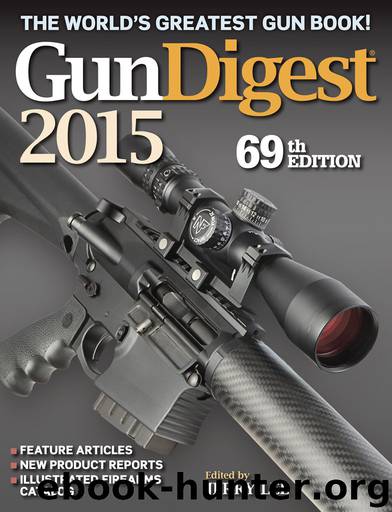Gun Digest 2015 by Lee Jerry

Author:Lee, Jerry
Language: eng
Format: epub
Publisher: F+W Media
The bayonet-lug sleeve was created in 1944, too late to be used on any carbines that saw action during WWII, although many guns were retrofitted with this sleeve afterward. It was designed for the M4 bayonet.
No, the first time I saw an M1 Carbine (Saturday matinee movies like Earth vs. The Flying Saucers and The Longest Day notwithstanding) was on the football field of the no-longer-existing West High School in Phoenix, where I was a member of the Junior Reserve Officers Training Corps (JROTC). However, as a low-ranking freshmen squad member, I was condemned to drilling with the M1 Garand. But the junior and senior cadet officers got to carry M1 Carbines nattily slung, muzzle up, over their right shoulders. Let me tell you, a 51⁄2-pound carbine versus a 91⁄2-pound rifle makes a big difference on the drill field, especially under a blazing southern Arizona sun when temperatures often climbed to well over 100 degrees. I suspect that was really the impetus behind my motivation to become an officer, a goal that carried over with me throughout ROTC at Arizona State University.
In any case, I finally got to carry an M1 Carbine, although not in the regular Army. By the time I made it to Officer’s Candidate School at Ft. Lewis, Wash., they were using different rifles entirely. But many years later, as fate would have it, Jim looked me up. It seemed he needed to raise some cash and decided to sell his NRA M1 Carbine. And like the true friend he was, he wanted to give me first dibs on it. Of course, after all these years Jim wanted more than the $20 he had originally paid for the gun, but that was understandable. A deal was quickly and almost painlessly consummated and at last the gun I had coveted so long ago was mine, complete with all the original NRA and Army Depot shipping papers plus the original cancelled check stub from Jim’s father.
My carbine, with its serial number in the 3,550,000 range, was made between May 1943 and February 1944 (specific years are not available) and was subsequently shipped from Red River Arsenal in Texarkana, Texas to Jim’s dad on Jan. 24, 1964. Jim had taken good care of it through the years and it still retained its 80 percent arsenal refinish. With factory ammo it consistently shoots 1-1⁄8-inch groups, which makes it ideal for coyotes and plinking, and it has yet to jam using military surplus magazines.
Download
This site does not store any files on its server. We only index and link to content provided by other sites. Please contact the content providers to delete copyright contents if any and email us, we'll remove relevant links or contents immediately.
| Ammo & Grenades | Firearms |
| Swords & Knives |
How to Be a Bawse: A Guide to Conquering Life by Lilly Singh(6734)
Spare by Prince Harry The Duke of Sussex(4255)
Millionaire: The Philanderer, Gambler, and Duelist Who Invented Modern Finance by Janet Gleeson(3607)
Harry Potter 02 & The Chamber Of Secrets (Illustrated) by J.K. Rowling(3306)
Urban Outlaw by Magnus Walker(2969)
The Heroin Diaries by Nikki Sixx(2956)
Never by Ken Follett(2952)
Japanese Design by Patricia J. Graham(2582)
The Club by A.L. Brooks(2412)
Machine Learning at Scale with H2O by Gregory Keys | David Whiting(2363)
The Man Who Died Twice by Richard Osman(2339)
Stacked Decks by The Rotenberg Collection(2303)
Harry Potter and the Deathly Hallows (7) by J.K. Rowling(2250)
Harry Potter and the Prisoner of Azkaban (Book 3) by J. K. Rowling(2172)
Fairy Tale by Stephen King(2141)
Will by Will Smith(2114)
Churchill by Paul Johnson(2032)
The Chimp Paradox by Peters Dr Steve(1886)
The 7 Habits of Highly Effective People: Powerful Lessons in Personal Change (25th Anniversary Edition) by Covey Stephen R(1854)
